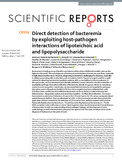Direct detection of bacteremia by exploiting host-pathogen interactions of lipoteichoic acid and lipopolysaccharide
Date
2019-04-17Author
Kubicek-Sutherland, Jessica Z.
Vu, Dung M.
Aneesa, Noormohamed
Mendez, Heather M.
Stromberg, Loreen R.
Pedersen, Christine A.
Hengartner, Astrid C.
Klosterman, Katja E.
Haley, A. Bridgewater
Otieno, Vincent
Cheng, Qiuying
Anyona, Samuel B.
Ouma, Collins
Raballah, Evans
Perkins, Douglas J.
McMahon, Benjamin H.
Mukundan, Harshini
Metadata
Show full item recordAbstract
Bacteremia is a leading cause of death in sub-Saharan Africa where childhood mortality rates are the highest in the world. The early diagnosis of bacteremia and initiation of treatment saves lives, especially in high-disease burden areas. However, diagnosing bacteremia is challenging for clinicians, especially in children presenting with co-infections such as malaria and HIV. There is an urgent need for a rapid method for detecting bacteremia in pediatric patients with co-morbidities to inform treatment. In this manuscript, we have developed and clinically validated a novel method for the direct detection of amphiphilic pathogen biomarkers indicative of bacteremia, directly in aqueous blood, by mimicking innate immune recognition. Specifically, we have exploited the interaction of amphiphilic pathogen biomarkers such as lipopolysaccharides (LPS) from Gram-negative bacteria and lipoteichoic acids (LTA) from Gram-positive bacteria with host lipoprotein carriers in blood, in order to develop two tailored assays – lipoprotein capture and membrane insertion – for their direct detection. Our assays demonstrate a sensitivity of detection of 4 ng/mL for LPS and 2 ng/mL for LTA using a waveguide-based optical biosensor platform that was developed at LANL. In this manuscript, we also demonstrate the application of these methods for the detection of LPS in serum from pediatric patients with invasive Salmonella Typhimurium bacteremia (n = 7) and those with Staphylococcal bacteremia (n = 7) with 100% correlation with confirmatory culture. Taken together, these results demonstrate the significance of biochemistry in both our understanding of host-pathogen biology, and development of assay methodology, as well as demonstrate a potential new approach for the rapid, sensitive and accurate diagnosis of bacteremia at the point of need.
URI
https://doi.org/10.1038/s41598-019-42502-5https://www.nature.com/articles/s41598-019-42502-5
http://r-library.mmust.ac.ke/123456789/1741
Collections
- Gold Collection [1026]

